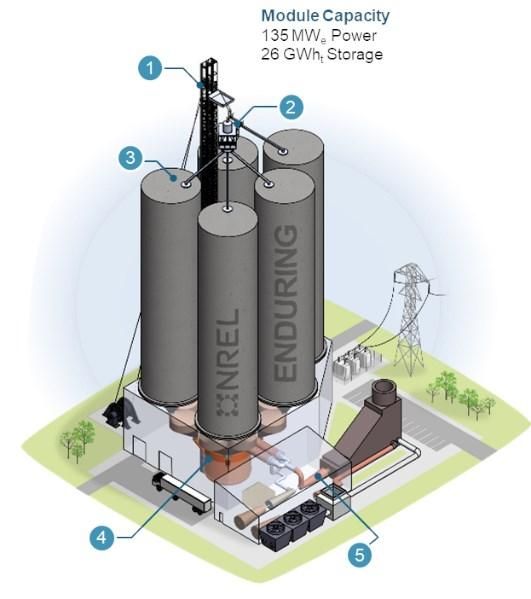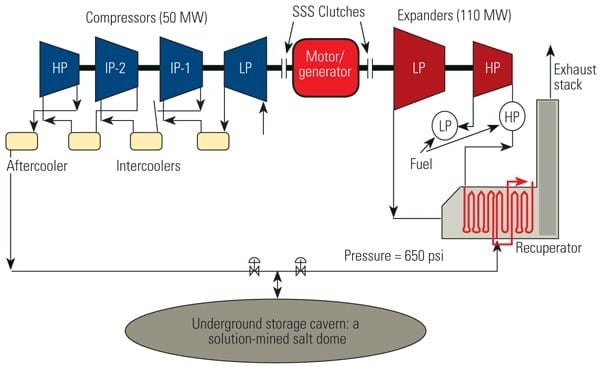Mid-Ohio Valley Climate Corner: The promise of heat batteries for cleaner air – News and Sentinel

Report on Sustainable Industrial Transformation in the Mid-Ohio Valley through Advanced Energy Storage
1.0 Executive Summary
The Mid-Ohio Valley (MOV) region is positioned to transition its industrial sector towards a more sustainable and economically resilient model. Decades of reliance on fossil fuels for industrial processes have resulted in significant environmental and public health concerns. This report examines the potential for innovative thermal energy storage solutions, such as the Rondo Heat Battery and the Polar Night Energy Sand Battery, to facilitate this transformation. The adoption of these technologies aligns directly with multiple United Nations Sustainable Development Goals (SDGs), offering a pathway to decarbonize industry, improve air quality, and foster sustainable economic growth.
2.0 Technological Overview: Thermal Energy Storage
Advanced thermal batteries represent a critical technology for decarbonizing high-temperature industrial processes currently dependent on fossil fuel combustion. These systems offer a clean, cost-effective alternative for thermal energy.
- Rondo Heat Battery: This system converts electricity into high-temperature heat (exceeding 1000°C), storing it in refractory materials for on-demand use in industrial applications. A 100-megawatt-hour unit is currently operational in California.
- Polar Night Energy Sand Battery: This technology stores heat in sand at temperatures up to 400°C, suitable for applications such as district heating, as demonstrated by its deployment in Finland.
These technologies enable industries to utilize electricity, particularly from renewable sources during off-peak hours, to power thermal operations, thereby eliminating the direct combustion of fossil fuels and associated emissions.
3.0 Alignment with Sustainable Development Goals (SDGs)
The integration of thermal battery technology in the MOV’s industrial landscape directly supports the achievement of several key SDGs:
- SDG 7: Affordable and Clean Energy: By storing energy from renewable sources as heat, these batteries increase the share of clean energy in the industrial sector, reducing reliance on fossil fuels and promoting energy independence from volatile price fluctuations.
- SDG 9: Industry, Innovation, and Infrastructure: Adopting these solutions constitutes a significant upgrade of industrial infrastructure, promoting clean and environmentally sound technologies and industrial processes. It fosters innovation and builds resilient infrastructure.
- SDG 11: Sustainable Cities and Communities: A primary benefit is the substantial reduction in localized air pollutants (NOx, SOx, particulate matter), leading to cleaner air and a healthier environment for communities throughout the MOV.
- SDG 3: Good Health and Well-being: The improvement in air quality directly contributes to better public health outcomes by reducing the incidence of respiratory illnesses associated with industrial pollution.
- SDG 13: Climate Action: The transition from fossil fuel combustion to clean electric heat drastically reduces the region’s carbon footprint, representing a direct and impactful measure to combat climate change.
- SDG 8: Decent Work and Economic Growth: This technological shift can attract new, environmentally conscious industries to the region, fostering sustainable economic growth and positioning the MOV as a leader in green industry.
- SDG 12: Responsible Consumption and Production: These systems promote more efficient and sustainable energy consumption patterns by enabling the use of off-peak and surplus renewable electricity, decoupling industrial production from fossil fuel consumption.
4.0 Regional Implications and Benefits
The adoption of thermal energy storage presents multifaceted benefits for the Mid-Ohio Valley.
4.1 Environmental Benefits
- Direct reduction in greenhouse gas emissions.
- Significant improvement in local air quality.
- Decreased environmental footprint of the industrial sector.
4.2 Economic Benefits
- Reduced operational costs by leveraging off-peak electricity rates.
- Insulation from the price volatility of fossil fuels.
- Enhanced grid stability by lowering peak electricity demand.
- Attraction of new investment and sustainable industries to the region.
5.0 Conclusion and Recommendation
The Mid-Ohio Valley has a strategic opportunity to modernize its industrial energy infrastructure and align its economic future with global sustainability targets. By embracing innovative thermal energy storage solutions, the region can transform its industrial landscape into a cleaner, healthier, and more economically resilient model. It is recommended that regional stakeholders, businesses, and policymakers explore and incentivize the adoption of these technologies to secure a sustainable and prosperous future powered by clean electricity rather than combustion.
Sustainable Development Goals (SDGs) Addressed
The article on sustainable energy storage technologies in the Mid-Ohio Valley (MOV) addresses several interconnected Sustainable Development Goals by highlighting a transition towards cleaner industrial processes.
-
SDG 7: Affordable and Clean Energy
The core theme of the article is the adoption of innovative energy storage solutions like the Rondo Heat Battery and Polar Night Energy Sand Battery. These technologies are presented as a way to provide “cost-effective and clean thermal energy,” directly supporting the goal of ensuring access to affordable, reliable, sustainable, and modern energy. The article emphasizes their role in utilizing electricity, particularly from renewable sources during off-peak hours, to “decarbonizing operations that currently depend on burning natural gas or other fossil fuels.”
-
SDG 9: Industry, Innovation, and Infrastructure
The article calls for the MOV to “modernize industrial energy infrastructure” by embracing “innovative thermal energy storage solutions.” This directly relates to building resilient infrastructure, promoting inclusive and sustainable industrialization, and fostering innovation. The text suggests that adopting these technologies would make industries more competitive and sustainable, transforming the region’s industrial landscape.
-
SDG 11: Sustainable Cities and Communities
By proposing a solution to reduce industrial pollution, the article connects to the goal of making cities and human settlements inclusive, safe, resilient, and sustainable. It explicitly states that switching to these heat batteries would lead to a “significant reduction in localized air pollutants like NOx, SOx, and particulate matter, leading to cleaner air for communities throughout the MOV.” This contributes to creating a healthier and more sustainable living environment for residents.
-
SDG 13: Climate Action
The article directly addresses climate action by stating that the shift away from fossil fuels would “contribute to a significant decrease in the region’s carbon footprint, aligning with global efforts to combat climate change.” The focus on decarbonizing high-temperature industrial heat processes is a specific strategy to combat climate change and its impacts.
-
SDG 3: Good Health and Well-being
A direct link to public health is made when the article discusses the benefits of reduced air pollution. It notes that “Fewer emissions from industrial stacks would mean fewer respiratory illnesses,” connecting environmental improvements directly to the well-being of the local population and the goal of ensuring healthy lives.
-
SDG 8: Decent Work and Economic Growth
The article touches upon sustainable economic growth by suggesting that environmental stability can “attract new, environmentally conscious industries to the region, fostering sustainable economic growth.” This implies that modernizing the industrial sector with clean technology can create new economic opportunities and lead to a more “economically resilient region.”
Specific SDG Targets Identified
Based on the article’s content, several specific SDG targets can be identified as directly relevant to the proposed technological transition.
-
Target 7.2: Increase the share of renewable energy
The article supports this target by describing how heat batteries can be charged during “periods of high renewable energy availability.” This facilitates greater integration of intermittent renewable sources into the energy grid, thereby increasing their overall share in the industrial energy mix.
-
Target 9.4: Upgrade infrastructure and retrofit industries to make them sustainable
This target is central to the article’s argument. The proposal for industries to switch from “gas-fired boilers” to Heat Batteries is a clear call to “retrofit industries” with “clean and environmentally sound technologies” to decarbonize their processes and improve sustainability.
-
Target 11.6: Reduce the adverse per capita environmental impact of cities, including by paying special attention to air quality
The article directly addresses this target by focusing on how the adoption of these technologies would result in a “direct reduction in air pollution” and “cleaner air for communities.” It specifically names pollutants like “NOx, SOx, and particulate matter” whose reduction would improve urban and regional air quality.
-
Target 3.9: Substantially reduce the number of deaths and illnesses from hazardous chemicals and air pollution
The article’s claim that cleaner air would lead to “fewer respiratory illnesses” directly aligns with this health-focused target, which aims to mitigate the negative health impacts of environmental pollution.
-
Target 13.2: Integrate climate change measures into policies and planning
While the article focuses on a regional initiative, it advocates for actions that align with this target. The call for the MOV’s industrial sector to reduce its “carbon footprint” represents the integration of climate change mitigation measures into regional industrial and economic planning.
Indicators for Measuring Progress
The article mentions or implies several indicators that could be used to measure progress towards the identified targets.
-
Reduction in Air Pollutants:
The article explicitly mentions “NOx, SOx, and particulate matter.” An indicator would be the measured concentration of these pollutants in the air in industrial areas of the MOV before and after the adoption of heat battery technology. This would directly measure progress towards Target 11.6.
-
Regional Carbon Footprint:
The text refers to a “decrease in the region’s carbon footprint.” A quantifiable indicator would be the total greenhouse gas emissions (measured in CO2 equivalent) from the MOV’s industrial sector. Tracking this metric over time would measure progress towards Target 13.2.
-
Adoption Rate of Clean Technology:
An indicator for Target 9.4 would be the number of industrial facilities in the MOV that have installed and are operating thermal energy storage systems like the Rondo or Polar Night batteries, or the total thermal energy capacity (in MWh) provided by these clean technologies.
-
Incidence of Respiratory Illnesses:
To measure progress towards Target 3.9, public health data on the “incidence rates of respiratory illnesses” in the MOV could be monitored. A decrease in these rates following improvements in air quality would serve as a key indicator.
-
Share of Renewable Energy in Industrial Heat:
For Target 7.2, an indicator would be the percentage of electricity used to charge industrial heat batteries that is sourced from renewable energy. This would measure the extent to which the new technology is facilitating the use of clean energy.
Summary of SDGs, Targets, and Indicators
| SDGs | Targets | Indicators |
|---|---|---|
| SDG 7: Affordable and Clean Energy | Target 7.2: By 2030, increase substantially the share of renewable energy in the global energy mix. | Percentage of industrial heat generated from systems charged with renewable energy. |
| SDG 9: Industry, Innovation, and Infrastructure | Target 9.4: By 2030, upgrade infrastructure and retrofit industries to make them sustainable…and with greater adoption of clean and environmentally sound technologies. | Number of industrial facilities in the MOV adopting thermal battery technology. |
| SDG 11: Sustainable Cities and Communities | Target 11.6: By 2030, reduce the adverse per capita environmental impact of cities, including by paying special attention to air quality. | Measured reduction in atmospheric concentrations of NOx, SOx, and particulate matter in the region. |
| SDG 13: Climate Action | Target 13.2: Integrate climate change measures into national policies, strategies and planning. | Reduction in the total carbon footprint (greenhouse gas emissions) from the MOV’s industrial sector. |
| SDG 3: Good Health and Well-being | Target 3.9: By 2030, substantially reduce the number of deaths and illnesses from…air…pollution and contamination. | Data on the incidence rates of respiratory illnesses among the local population. |
| SDG 8: Decent Work and Economic Growth | Target 8.4: …decouple economic growth from environmental degradation… | Number of new, environmentally conscious industries established in the region. |
Source: newsandsentinel.com
What is Your Reaction?
 Like
0
Like
0
 Dislike
0
Dislike
0
 Love
0
Love
0
 Funny
0
Funny
0
 Angry
0
Angry
0
 Sad
0
Sad
0
 Wow
0
Wow
0




















































.jpg.webp?itok=0ZsAnae9#)



























